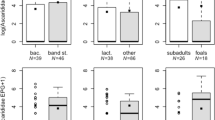Abstract
The free-living third-stage larvae (L3) of gastrointestinal nematodes are able to tolerate extreme weather conditions such as desiccation, but little is known about the consequent effects this has on their fitness. This study explored how the desiccation of Haemonchus contortus L3 larvae affected their absolute fitness by examining their success at consequent life cycle stages for a complete generation, and comparing them against a control. The stages examined include establishment, fecundity, larval development and pathogenicity. The results show that while desiccation greatly reduced the survival of the L3 prior to infection in sheep, their absolute fitness was not negatively impacted. Instead, it appears desiccation slightly augmented H. contortus fitness by triggering increases in fecundity. The study further explored what influence different gastrointestinal nematode (GIN) species (H. contortus, Trichostrongylus colubriformis, Teladorsagia circumcincta), isolates and age of L3 had on their capacity to revive following various periods of desiccation. The results showed desiccation tolerance varied as a function of each of these variables. The greatest L3 survival was found in Te. circumcincta followed by Tr. colubriformis and finally H. contortus. Significant variation was observed between individual species isolates and as a function of age. The results of this study carry important practical implications for the epidemiological understanding of gastrointestinal nematode species of economic importance.




Similar content being viewed by others
References
Baermann G (1917) Eine einfach methode zur auffindung von Ankylostomun – (Nematoda) – larven in erdproben. Welteureden Batavia Geneesk. Lab. Feestbundel 41-47
Cabaret J, Ouhelli H (1984) Fertility of parasitic strongyles in the digestive system of sheep under natural conditions. Rev Med Vet 135:627–633
Clegg JS (2001) Cryptobiosis—a peculiar state of biological organization. Comp Biochem Physiol B Biochem Mol Biol 128:613–624
Gaba S, Chadoeuf J, Monestiez P, Sauve C, Cortet J, Cabaret J (2006) Estimation of abomasum strongyle nematode infections in sheep at necropsy: tentative proposals for a simplified technique. Vet Parasitol 140:105–113
Harvell CD, Mitchell CE, Ward JR, Altizer S, Dobson AP, Ostfeld RS, Samuel MD (2002) Climate warming and disease risks for terrestrial and marine biota. Science 296:2158
Jacquiet P, Cabaret J, Cheikh D, Thiam A (1995) Experimental study of survival strategy of Haemonchus contortus in sheep during the dry season in desert areas of the Mauritania. J Parasitol 81(6):1013–1015
LeJambre LF (1977) Genetics of vulvar morph types in Haemonchus contortus: Haemonchus contortus cayugensis from the finger lakes region of New York. Int J Parasitol 7:9–14
Makovcová K, Jankovska I, Vadlejch J, Langrova I, Vejl P, Lytvynets A (2009) The contribution to the epidemiology of gastrointestinal nematodes of sheep with special focus on the survival of infective larvae in winter conditions. Parasitol Res 104:795–799
Medica DL, Sukhedo MVK (1997) Role of lipids in the transmission of infective stage (L3) Strongylus vulgaris (Nematoda: Strongylida). J Parasitol 83:775–779
Persson D, Halber KA, Jørgensen A, Ricci C, Møbjerg N, Kristensen RM (2011) Extreme stress tolerance in tardigrades: surviving space conditions in low earth orbit. J Zool Syst Evol Res 49 (Suppl. 1) 90 – 97
Poulin R (1998) Evolutionary ecology of parasites: from individuals to communities. Chapman and Hall, London
Raynaud JP (1970) Etude de l’efficacité d’une technique de coproscopie quantitative pour le diagnostic le routine et le controle des infestations parasitaires des bovins, ovins, equins et porcins. Ann Parasitol 45:321–342
Roos MH, Otsen M, Hoekstra R, Veenstra JG, Lenstra JA (2004) Genetic analysis of inbreeding of two strains of the parasitic nematode Haemonchus contortus. Int J Parasitol 34:109–115
Rossanigo CE (1992) Role de l’eau et de la température sur les taux de développement des nématodes parasites du tractus digestif des ruminants. PhD dissertation, Université Montpellier II
Rossanigo CE, Gruner L (1994) Relative effect of temperature and moisture on the development of stronglye eggs to infective larvae in bovine pats in Argentina. Vet Parasitol 55:317–325
Rossanigo CE, Gruner L (1996) The length of strongylid nematode infective larvae as a reflection of developmental conditions in faeces and consequences on their viability. Parasitol Res 82(4):304–311
Selvan S, Guagler R, Lewis EE (1993) Biochemical energy reserved of entomopathogenic nematodes. J Parasitol 79:167–17
Siamba DN, Gatongi PM, Mulambalah CS, Ngeiywa MM, Wamae LW, Wambugu A (2011) Changes in lipids utilisation during moisture and temperature stress of infective (L3) and its implication on the epidemiology of Haemonchus contortus in arid and semi arid lands. Curr Res J Biol Sci 3(2):88–94
Siamba DN, Mulambalah CS, Ngeiywa MM, Gatongi PM, Wamae LW (2012) Exsheathment characteristics and infectivity of revived anhydrobiotic L3 of Haemonchus contortus. Int J Anim Vet Adv 4(5):316–320
Viney M, Cable J (2011) Macroparasite life histories. Curr Biol 21:R767–R774
Vlassoff A, Leathwick DM, Health ACG (2001) The epidemiology of nematode infection in sheep. New Zeal Vet J 49(6):213–221
Watanabe M (2006) Anhydrobiosis in invertebrates. Appl Entomol Zool 41:15–31
Acknowledgments
C. Chylinski is a grateful recipient of a Ph.D. grant from the EU Marie Curie Project “NematodeSystemHealth”. We thank W. Pomroy, Massey University, New Zealand, for providing anthelmintic-resistant isolates.
Author information
Authors and Affiliations
Corresponding author
Rights and permissions
About this article
Cite this article
Chylinski, C., Lherminé, E., Coquille, M. et al. Desiccation tolerance of gastrointestinal nematode third-stage larvae: exploring the effects on survival and fitness. Parasitol Res 113, 2789–2796 (2014). https://doi.org/10.1007/s00436-014-3938-1
Received:
Accepted:
Published:
Issue Date:
DOI: https://doi.org/10.1007/s00436-014-3938-1




